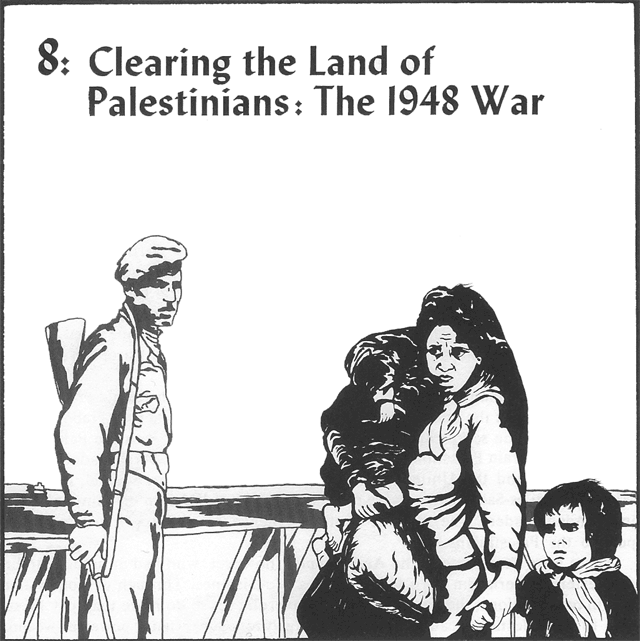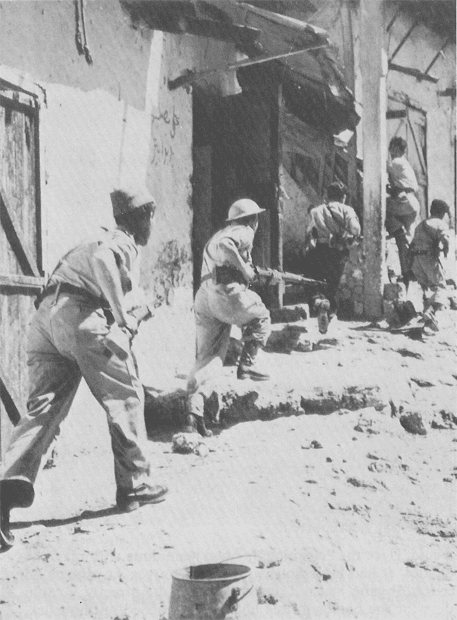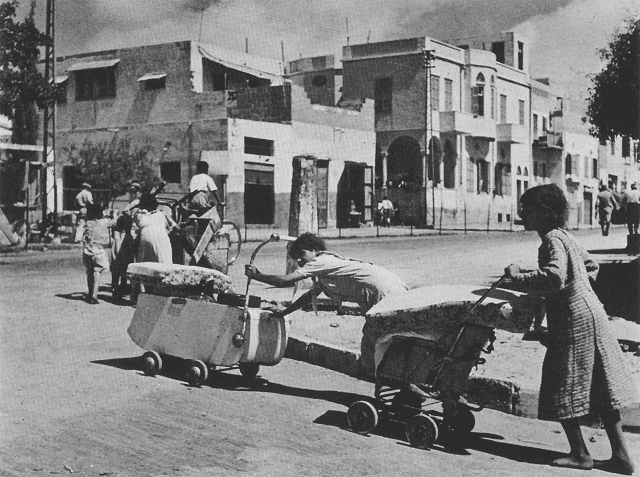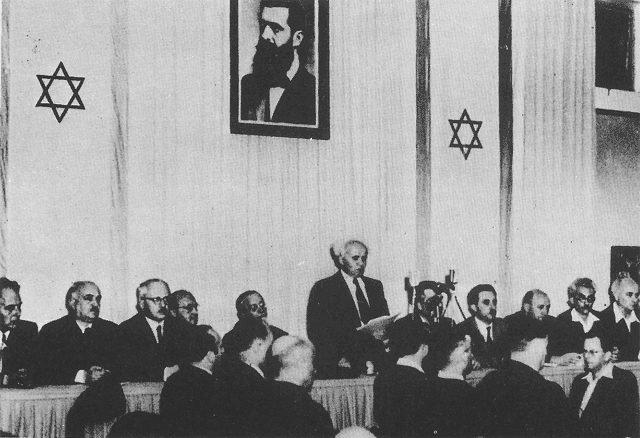Our Roots Are Still Alive - Chapter 8
Previous: Chapter 7
Table of Contents
Next: Chapter 9
New Jersey Solidarity-Activists for the Liberation of Palestine Main Site

- I noticed the tears in the eyes of our people. There was a bitter feeling in every heart. Some of the old men were willing to die fighting for our land. but they were without arms.
- Fouad Yasin, Palestinian radio announcer
On November 29, 1947, the night partition was announced in Palestine, Zionist settlers danced through the streets of Jerusalem and Tel Aviv. When some dancers burst onto David Ben-Gurion's study, he hurried them away and returned to poring over military maps. The maps showed that over one-half of all Jewish settlers lived in three major cities, while the Palestinian Arabs lived in every city and in Arab villages throughout Palestine. Ben-Gurion studied each Arab village, focusing on the details of its strategic importance, its inhabitants, and its surrounding terrain.
Ben-Gurion had already ordered a secret mobilization of all soldiers in the Zionist army, the Haganah, and in the Palmach, the assault troops of the Haganah. Earlier in November, four special agents had departed for Europe with three million dollars of credits raised in the United States. Their mission was to buy rifles, machine guns, airplanes and artillery. In the outlying kibbutzim, secret arms factories, built from smuggled materials supplied by American Zionists, turned out small arms. Zionists were negotiating with Czechoslovakia for a large arms purchase.1 Ben-Gurion was preparing a military offensive designed to seize much more of Palestine for the Zionist state than the United Nations had assigned to it. He called this offensive "Plan Dalet." It would begin as soon as enough British troops withdrew from Palestine.2
For Palestinian Arabs, the threat of war hung heavy in the air the night of partition. They listened to the wild celebration in the streets. They talked of how to defend their nation in the upcoming fight. No arms were arriving from Europe for the Palestinians. The weapons they possessed dated from the 1936 rebellion. In all of Jaffa, there were only eight machine guns. The British Emergency Laws, enacted during the 1936 Palestinian rebellion, still condemned to death any Palestinian found with a gun. Two small Palestinian guerrilla groups had continued to train in the hills throughout the Second World War. The only central leadership, the Arab Higher Committee, had been banished ten years ago. Recently re-formed, it no longer had the power to rally Palestinians behind it. The Palestinians faced a Zionist military that was perhaps the best led and best organized of all European settler armies.
The hopes of many Palestinians turned to the other Arab countries. The Arab League, formed at the end of the war to coordinate the activities of Arab countries, was quick to issue scores of statements expressing solidarity with the Palestinians. But it failed to train Palestinians or to provide them with arms. Arab leaders depended on Britain and the United States to maintain their power. Several, like Prime Minister Nuri es-Said of Iraq, were more employees of Western oil companies than independent leaders. They did not want to challenge imperialism by giving full support to the Palestinians.
There were those among the Arab peoples, however, who had an understanding of Western imperialism born from decades of resistance. Through demonstrations and in organizations, they pressured their governments to do more than pay lip service to the Palestinian cause. Some Arab organizers suggested a powerful weapon: an oil boycott against the United States and Britain. In 1947, Syria had refused to sign an agreement with the United States to complete an oil pipeline. Workers in Lebanon and Transjordan stopped work on the line in enthusiastic support. But King Ibn Saud of Saudi Arabia sabotaged the work stoppage to protect the royalties that flowed directly into his palace from the profits of United States oil corporations. Palestinians understood from betrayals like this that they could expect only token help from the Arab governments.
In December 1947, the British announced that they would withdraw from Palestine by May 15, 1948. Palestinians in Jerusalem and Jaffa called a general strike against the partition. Fighting broke out in Jerusalem's streets almost immediately. The Zionists were prepared to seize every opportunity to escalate the fighting. A lightning war was their only hope to defeat the Palestinians, who outnumbered the Zionists and lived in all parts of the partitioned country. A lengthy battle could only favor the Palestinians. Violent incidents mushroomed into all-out war.

Zionist soldiers invade a town.
Palestinians fought in small guerrilla bands, in village militias, or in the ranks of the Arab Liberation Army, a poorly armed force of a thousand Palestinians and three thousand volunteers from other Arab countries. The people of Palestine supported the fighters as best they could. Women organized groups called "daisy chains" to smuggle arms into the hills, to dig trenches and to organize medical supplies. Casualties were high. By February the Palestinians were outmatched with twenty-five thousand Arabs fighting fifty thousand Zionist troops.3
Plan Dalet
Throughout the winter of 1948 Haganah and Irgun soldiers carried out night raids on Arab villages. The Haganah defined the purpose of these raids as "not to punish but to warn." Soldiers attacked quiet villages that had not been involved in the fighting to demonstrate "the Haganah's long arm."4 Haganah troops entered a village and silently placed dynamite around the stone houses, drenching the wooden doors and window frames with gasoline. Then, stepping back, they opened fire with their guns. The sleeping inhabitants died in the explosion and fire that destroyed their homes.5
Such "warnings" caused some villagers to flee their homes, but often only to another part of Palestine, no far enough away for the Zionists. The Zionist goal was to "clear the land" of its Arab inhabitants, but Palestinian leaders urged the people to stay and fight. In March Ben-Gurion put Plan Dalet - an all-out attack throughout the whole of Palestine - into effect.6 At the heart of his strategy was the systematic expulsion of the Palestinian Arab population. As long as most Palestinians stayed in Palestine, the Zionists could not win a decisive victory.
The attack began with the use of psychological terror. On March 28, the Zionist Free Radio broadcast this warning in Arabic:
- Do you know it is a sacred duty to inoculate yourselves against cholera, typhus and similar diseases, as it is expected that such diseases will break out heavily in April and May among Arabs in the cities?7
Such broadcasts were not directed at Palestinian soldiers. Their purpose was to create fear in villagers, farmers and families in the cities and encourage them to flee. At Deir Yassin, a small Arab village near Jerusalem, psychological terror turned into a full-fledged massacre.
Deir Yassin was a quiet village. Its inhabitants had cooperated with the Jewish Agency and kept Arab troops out of their town.8 On April 9, Irgun soldiers entered the village and told the residents they had fifteen minutes to abandon their homes. Then the bands of soldiers attacked. In a few hours, the Irgun had murdered two hundred fifty-four people - men, women and children - in cold blood.9 Over the protests of the Jewish Agency, Jacques de Reynier of the International Red Cross visited Deir Yassin a few days later. He met the soldiers of the Irgun in the process of "cleaning up." This is what he reported:
- I found some bodies cold. Here the "cleaning up" had been done with machine guns, then hand-grenades. It had been finished off with knives, anyone could see that... As the [Irgun] gang had not dared to attack me directly, I could continue. I gave orders for the bodies in this house to be loaded on the truck, and went into the next house, and so on. Everywhere, it was the same horrible sight. I found only two more people alive...10
The Irgun took the few survivors to Jerusalem and paraded them through the streets as crowds spit upon them. Although the Jewish Agency piously condemned the massacre at Deir Yassin, the Irgun was admitted to the Joint Command of the military with the Haganah the same day.11 The actions of the Irgun served the Zionist plan well. The destruction of Deir Yassin, which was skillfully publicized by the Zionists, sparked an exodus of Palestinian families who feared a similar fate. During the joint Irgun-Haganah attack on the Palestinian quarter of Haifa, the news of the massacre which had occurred twelve days before convinced many to flee.
On April 21, 1948, the British commander of Haifa advised the Zionists that he was withdrawing his troops. He did not tell Palestinian leaders. At sundown the Zionists began their attack on Haifa Arabs with Davidka mortars, which hurled sixty pounds of explosives about three hundred yards into the crowded Arab quarter. Barrel bombs, which were casks filled with gasoline and dynamite, rolled down the narrow alleys and crashed, creating an inferno of flames and explosions. Haganah loudspeakers broadcast "horror recordings" that filled the air with the shrieks and anguished moans of Arab women, interrupted by a booming sorrowful voice that called out in Arabic, "Flee for your lives! The Jews are using poison gas and atomic weapons!" As Palestinians fled their city, the Irgun commander reported that they cried, "Deir Yassin! Deir Yassin!"12
 Palestinians flee Jaffa.
Palestinians flee Jaffa.
Within a week the same psychological blitz," as the Zionists called it, emptied the port city of Jaffa, a city designated as part of the Arab state. Only three thousand of he eighty thousand Arabs of Jaffa remained. Jon Kimche, a Zionist historian, reported that the soldiers "commenced to loot in wholesale fashion... Everything that was movable was carried from Jaffa [and] what could not be taken away was smashed."13 From the fertile fields of Galilee to the fortress city of Acre, the Zionist campaign drove the Palestinians from their homes, their villages, their lands. The several hundred thousand who remained lived under Zionist occupation.
During that fateful April of 1948, eight out of the thirteen major Zionist military attacks on Palestinians occurred in the territory granted to the Arab state by the United Nations.14 By May 15, as the British ended their long rule over Palestine, three hundred thousand Palestinians were exiles, living hand-to-mouth in the Jordan valley, Lebanon and Syria. The Jewish Agency cynically announced that the exodus of Arabs from Palestine was due to "flight psychosis."15
 Ben-Gurion proclaims the State of Israel.
Ben-Gurion proclaims the State of Israel.
"Proclaim the State, No Matter What"
On Passover, April 24, Ben-Gurion had announced at a victory feast in Jerusalem: "We stand on the eve of a Jewish State." He had already set the date in his mind. As the British ended their rule on May 15, 1948, the Zionists would begin theirs. Ben-Gurion planned to cut off the lingering debate in the UN about the partition plan by confronting the world with the actual existence of the new state. Chaim Weizmann, the elder statesman of Zionism, telegraphed his advice: "Proclaim the state, no matter what else ensues."16
Zionist leaders approached President Truman and worked out the details of U.S. recognition. At 6:00 p.m. on May 15, David Ben-Gurion proclaimed the existence of Israel. Eleven minutes later, President Truman cabled American recognition of the Jewish state.
A messenger rushed into the United Nations to inform the members of the turn of events; even the U.S. ambassador had not been informed. Arab delegates charged that the United Nations had again served as a backdrop for the maneuvers of the United States. The Soviet Union, still hoping that the creation of the new state might mean an end to imperialist control of Palestine, added its recognition a few days later.
People in the Arab countries knew better. The news of Deir Yassin and other violent incidents had created an intense concern and anger over the fate of the Palestinians. As Committees for Palestine called meetings and demonstrations throughout the Arab countries, Arab leaders knew they had to respond. The Arab League hastily called for its member countries to send regular army troops into Palestine. They were ordered to secure only the sections of Palestine given to the Arabs under the partition plan. But these regular armies were ill-equipped and lacked any central command to coordinate their efforts. King Abdullah of Transjordan, the official commander-in-chief, was busy negotiating with British and Zionist leaders for a slice of Palestine.17 Abdullah wanted to attach to his own kingdom any Palestinian territory not occupied by the Israelis. He promised that his troops, the Arab Legion, the only real fighting force among the Arab armies, would avoid fighting with Jewish settlements.18 Under Abdullah's self-serving leadership the armies of the Arab League had little effect. A few individual units - most notably those of young Egyptians - fought fiercely, but often with no support from their generals. Yet Western historians record this as the moment when the young state of Israel fought off the "overwhelming hordes" of five Arab countries!
In reality, the Israeli offensive against the Palestinians intensified. British Major Edgar O'Ballance described the new phase:
- [T]he Arab inhabitants were ejected and forced to flee into Arab territory, as at Ramleh, Lydda and other places. Wherever the Israeli troops advanced into Arab country, the Arab population was bulldozed out in front of them.19
On July 11, 1948, Moshe Dayan led a jeep commando column into the town of Lydda. Rifles, Sten guns and submachine guns blasted at everything that moved. Within minutes, the streets were silent, strewn with corpses of men, women and children.20 The next day, the Israelis seized the adjoining town of Ramleh. Loudspeakers announced that all Arabs had forty-eight hours to leave. Israeli soldiers stripped each person of all belongings - even food - at the bridges leaving the town. As Israeli troops sacked the town, a hundred thousand Palestinians began a painful march into exile.21 For three days, without food and water, the refugees walked in the sweltering sun towards the Transjordan hills. Many old people and children died of thirst.
"An Insuperable Problem"
When the fighting persisted and it became clear that the partition plan had broken down, the United Nations sent a mediator, Count Folke Bernadotte, to try to arrange a cease-fire and to secure the rights of the Palestinians. Numerous cease-fires which he arranged broke down as the Israelis continued their drives into Arab territory.22 Bernadotte urged Israel to allow the Palestinians to return to their homes. Israeli Foreign Minster Moshe Shertok replied: "On the economic side, the reintegration of the returning Arabs into normal life... would present an insuperable problem."23
In reality, the "problem" was that the new state depended on the homes, land and shops left behind by the exiled Palestinians. New Jewish settlers were already arriving, moving into Arab houses and reopening Arab businesses. The wealth of the exiled Palestinians - 80 percent of the land, 50 percent of the citrus groves, 90 percent of the olive groves, and ten thousand shops - was needed to build the new state of Israel.24

Bernadotte continued to press for Palestinians' right to return. His reports documented the forced flight of the Palestinians and their desire to return once peace was established. Finally on September 17, members of the Stern Gang assassinated Bernadotte. Waves of shock rippled through the United Nations and Western capitals at the news of his murder. New pressure mounted on Israel to accept a cease-fire. On January 7, 1949, a prolonged cease-fire went into effect. The new state of Israel encompassed 80 percent of Palestine! The key to victory had been the forcible eviction of the Palestinian Arab population. Chaim Weizmann observed that exodus of the Palestinians was a "miraculous simplification of our tasks."25
The Western world celebrated the birth of the new state. In America, Senators, members of Congress and the President applauded the "miracle of Israel." A rush of books and articles, like the best-seller Exodus, told the story of Israel as the victory of a valiant and intelligent people, the Israelis, over hordes of dark-skinned, dishonest and backward Arabs. The story had the drama of the popular Hollywood Westerns that dominated the American screen. It also had the same point: the attack on native people and the conquest of their land, whether Palestinian or Indian, was not only legitimate, but courageous and inspiring. It was a useful lesson to teach as American leaders launched the Cold War. It helped mobilize the American people behind the U.S. drive to seize the resources of other countries. An atmosphere of fear and hatred of "backward and uncivilized" people, from the Koreans to the Arabs, gripped the country. Israel represented a victory that both recaptured America's pioneer days and gave Israel's American supporters an emotional stake in U.S. domination of the Middle East.
The truth about the Palestinian Arabs lay buried in this avalanche of propaganda. In 1959 an American Jew, Nathan Chofshi, who had settled Palestine in 1908, wrote to the American Jewish Newsletter, protesting an article by Rabbi Mordecai Kaplan. Kaplan had argued that Arab leaders told the Palestinians to leave. Chofshi wrote:
- If Rabbi Kaplan really wanted to know what happened, we old Jewish settlers in Palestine who witnessed the flight could tell him how and in what manner we, Jews, forced the Arabs to leave cities and villages which they did not want to leave of their own free will. Some of them were driven out by force of arms; others were made to leave by deceit, lying and false promises.26
Over seven hundred fifty thousand Palestinians had been driven out of Palestine to create the state of Israel.27 King Abdullah annexed the Palestinian West Bank to Transjordan, renaming his enlarged kingdom simply Jordan. King Farouk of Egypt took over the administration of the Gaza Strip. Palestine disappeared from Western maps.
The people of Palestine did not forget. The memories of the terror of the spring of 1948 mingled with the memory of other springs in Palestine, when the land was theirs and grew under their care. Ghassan Kanafani, an exiled Palestinian writer, described the flight of his family from Jaffa in a story called The Land of Sad Oranges. He recalled
- ... the long queue of lorries, leaving the land of oranges far behind and spreading out over the winding roads of Lebanon. Then I began to weep, howling with tears. As for [my] mother, she eyed the oranges silently and all the orange trees [my] father had left behind to the Jews were reflected in his eyes; all the wholesome orange trees he had acquired one by one were visible in his face and glistened through the tears he could not check, even in front of the officer. When we arrived in Sidon that afternoon, we had become homeless.28
Footnotes
- Tabitha Petran, Zionism, A Political Critique, p. 10, using sources from Walid Khalidi, "Plan Dalat, The Zionist Master Plan for the Conquest of Palestine," Middle East Forum (November 1961).
- Nathaniel Lorch, The Edge of the Sword (New York: 1961), p. 87, cited by Childers, "The Wordless Wish," in The Transformation of Palestine, p. 180.
- Compiled from various sources, including Fred J. Khouri, The Arab-Israeli Dilemma (New York: 1969), cited by Dana Adams Schmidt, Armageddon in the Middle East (New York: 1974), p. 123.
- Jon Kimche and David Kimche, Both Sides of the Hill (London: 1960), cited by Childers, p. 182.
- Ibid.
- David Ben-Gurion, Rebirth and Destiny of Israel, translated and edited by Mordechai Nurock (New York: 1954), p. 39, cited by Childers, p. 183.
- BBC Monitoring Records, British Museum, cited by Childers, p. 183.
- Sykes, Crossroads to Israel, p. 416.
- Numerous sources cited by Childers, p. 185.
- Jacques de Reynier, "A Jerusalem un Drapeau Flottait sur la Ligne de Feu," in Khalidi, From Haven to Conquest, p. 764.
- George Eden Kirk, A Short History of the Middle East (London: 1948), cited by Sykes, p. 418.
- From numerous pro-Zionist sources cited by Childers, pp. 188-89.
- Jon Kimche, Seven Fallen Pillars (London: 1950), p. 233, cited by Childers, p. 191.
- Petran, p. 11, citing Khalidi, "Plan Dalet, the Zionist Master Plan for the Conquest of Palestine."
- New York Times, 4 May 1948, 1:6,8, cited by Robert John and Sami Hadawi, The Palestine Diary, 2:342.
- Sykes, p. 432.
- Jon Kimche and David Kimche, A Clash of Destinies: The Arab-Jewish War and the Founding of the State of Israel (New York: 1970), p. 60, cited by John and Hadawi, 2:295.
- Aref el-Aref, The Tragedy 1947-1952 2 vols. (Sidon, Lebanon: 1956), 1:65-67, cited by John and Hadawi, 2:295-96.
- Edgar O'Ballance, The Arab-Israeli War, 1948 (London: 1956), pp. 171-72, cited by Childers, p. 194.
- Kenneth Bilby, New Star in the Near East (New York: 1950), p. 43, cited by Childers, p. 194.
- Kimche, Both Sides of the Hill, p. 228, cited by Childers, p. 194; London Economist, 21 August 1948, cited by Childers, p. 194.
- Sykes, pp. 435-36.
- United Nations Security Council, Official Records, Suppl. 108 (S/949), August 1948, pp. 106-9, cited by Childers, p. 195.
- Don Peretz, Israel and the Palestine Arabs (Washington D.C.: 1958), cited by Childers, p. 195.
- James G. McDonald, My Mission to Israel 1948-1951 (New York: 1951), cited by Childers, p. 196.
- "The Bitter Truth about the Refugees," Jewish Newsletter (New York), 9 February 1959, cited by Childers, p. 184.
- Janet Abu-Lughod, "The Demographic Transformation of Palestine," in The Transformation of Palestine, pp. 147-61.
- Anni Kanafani, Ghassan Kanafani (Beirut: 1973), p. 10.